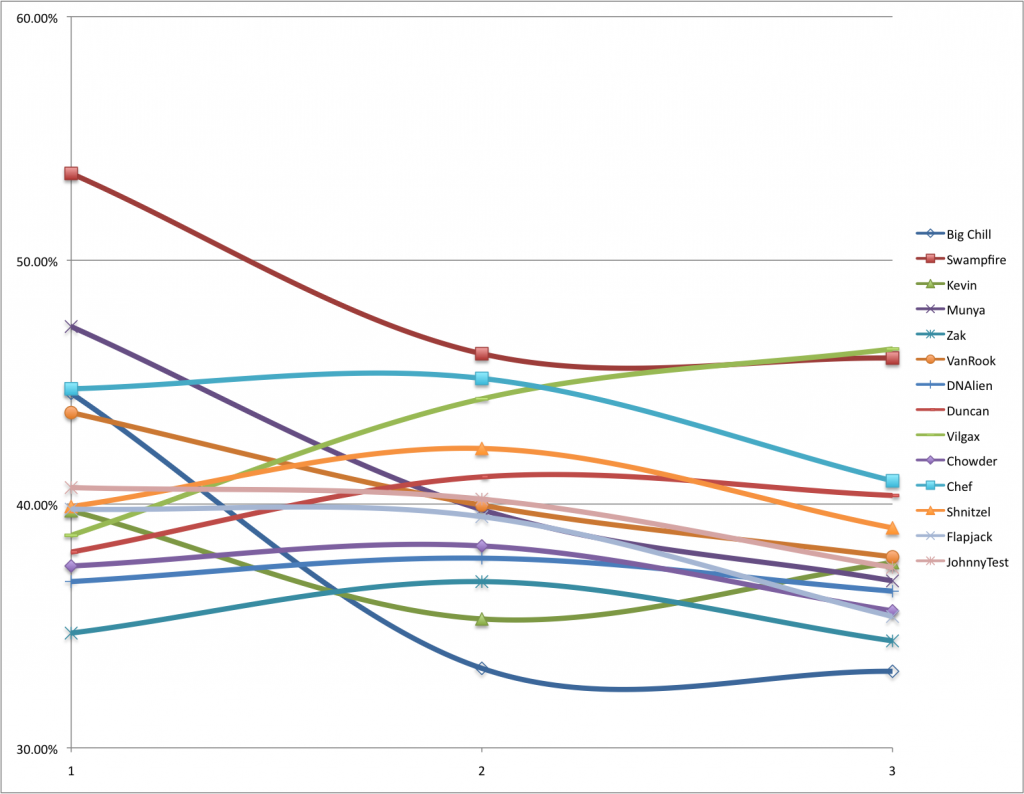Balancing Act
Over the past couple of years I have been working on character-based competitive games. These are the kind of games where the word “balance” is repeated ad nauseam. As a (somewhat) competitive fighting game player myself, I have strived tirelessly to make our games as balanced as possible. I have created complex tables to value character abilities, poured over win/loss data, and charted every balance change I have made and the corresponding results. I have seen the delicate balance these games have, the slightest adjustment can take a character from best to worst. A little nudge back the other way take the worst character to incredibly overpowered.
It’s been said that true balance in these types of games should be a designer’s goal, even though it’s impossible to accomplish. However, after working on these games, and watching the players and communities, I have come to the conclusion that not only is perfect balance impossible, a perfectly balanced game is not as good as a somewhat imbalanced game.
Emotionally Imbalanced
There are more factors at play in competitive games than just numbers, there are emotional factors as well. An imbalanced game benefits from this. When a game is imbalanced, it creates stories. There are villains (the overpowered) and underdogs (the underpowered) and all manner of journeymen in between. People love to see underdogs win and champions fall.
Perhaps you have seen this Street Fighter video of Ken defeating Chun-li. There is a lot of factors behind this video, the players, the pressure of the tournament, the technical skill of the feat but there is also the emotional factor for players of the game: Chun-li is overpowered. Granted, Ken is top-level character as well, but seeing Chun-li lose feels good. Now imagine that video was the most powerful character defeating the least powerful character. The emotion would go the other direction entirely.
Imagine a game that was truly balanced, there would not be the strong stories of pulling out a win when disadvantaged. Players would not be able to shrug off losses against overpowered characters, thereby retaining their sense of self-worth. Much of the underlying emotional responses to these types of games would be lost. Players claim to desire a perfectly balanced game but this mythical game would remove a great deal of what they love about character-based competitive games.
Goals
Eschewing the concept of a perfectly balanced game is rather freeing for a designer. Since we are now ignoring the concept of a perfectly balanced game, what are our design goals?
- A range of balance, not a perfect balance. Set an acceptable range.
- Be aware of imbalance and design for it. Knowingly create your villains and underdogs.
Warning Signs
This goal of imbalance can go too far. What are the warning signs that our balance is out of hand?
- Players are not choosing a variety of characters.
- Players default to a certain character after losing
Balancing Along the Way
You are going to be making tweaks as you go. What should inform your design decisions?
- Are the characters fulling the role you meant them to fill such as run away, hit & run, rushdown, etc.?
- Is a character far outside of your balance range?
- Does a character come down to repeating one action over and over?
An Example
Our fighting game, TKO, is a relatively simple game and therefore much easier to balance than most fighters. However, there were some challenges. Let’s take a look at the character wins over our three releases. (The percentages are wins per play but are lower than 50% due to dropped players)
You can see on the red-square line we had a character (Swampfire) far out of the acceptable range. It turned out he had a bug and one of his moves was much more powerful than intended. Fixing this bug brought him down to an acceptable range but kept him at the top of the rankings.
The blue-square line (Chef) & the purple-X line (Munya) characters shared a bug that we didn’t find until Release 2. They dropped slightly but stayed well in the acceptable range.
The blue-diamond line (Big Chill) was a character that had a very abusable move that players just repeated over and over. While he was not as overpowered as Swampfire, playing against him was frustrating for players and a detriment to the game. Fixing this abusable move dropped him significantly in the ratings, to the very bottom. He even received some significant buffs by release 3 but players still tried to win by abusing this now non-working strategy. I haven’t run the numbers lately but I wonder if these players have learned their lesson and Big Chill’s win percentage has improved? Or maybe I made him too underpowered and he could not recover?
More to Come
Our new game Project Exonaut has the same character-based flavor of TKO and am keeping up with balance all the time. I will be posting my finding here along with my predictions of balance and the results.
Conclusion
I am in no way condoning ignoring balance entirely but designers should be aware of the emotional factors a somewhat imbalanced game creates and how valuable those factors are. As long as your players choose their place in the balance and you game continues to display variety of players, embrace the imbalances and enjoy the endless debates of which character is the best.
